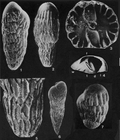Foraminifera taxon details
Afrobolivina Reyment, 1959 †
721464 (urn:lsid:marinespecies.org:taxname:721464)
accepted
Genus
Afrobolivina afra Reyment, 1959 † (type by original designation)
- Species Afrobolivina afra Reyment, 1959 †
- Species Afrobolivina bantu Reyment, 1959 †
marine, brackish, fresh, terrestrial
fossil only
feminine
Reyment, R. A. (1959). The Foraminiferal Genera Afrobolivina gen. nov. and Bolivina in the Upper Cretaceous and Lower Tertiary of West Africa. <em>Stockholm contributions in geology.</em> 3(1): 1-57.
page(s): p. 19 [details]
page(s): p. 19 [details]
Hayward, B.W.; Le Coze, F.; Vachard, D.; Gross, O. (2024). World Foraminifera Database. Afrobolivina Reyment, 1959 †. Accessed at: https://www.marinespecies.org/foraminifera/aphia.php?p=taxdetails&id=721464 on 2024-04-23
Date
action
by
original description
Reyment, R. A. (1959). The Foraminiferal Genera Afrobolivina gen. nov. and Bolivina in the Upper Cretaceous and Lower Tertiary of West Africa. <em>Stockholm contributions in geology.</em> 3(1): 1-57.
page(s): p. 19 [details]
basis of record Loeblich, A. R.; Tappan, H. (1987). Foraminiferal Genera and their Classification. Van Nostrand Reinhold Company, New York. 970pp., available online at https://books.google.pt/books?id=n_BqCQAAQBAJ [details] Available for editors [request]
[request]
additional source Revets, S. A. (1996). The generic revision of five families of Rotaliine Foraminifera - Part 1. The Bolivinitidae Cushman, 1927. <em>Cushman Foundation for Foraminiferal Research, Special Publication.</em> 1-55., available online at https://cushmanfoundation.allenpress.com/Portals/_default/SpecialPublications/sp34.pdf [details] Available for editors [request]
[request]
page(s): p. 19 [details]
basis of record Loeblich, A. R.; Tappan, H. (1987). Foraminiferal Genera and their Classification. Van Nostrand Reinhold Company, New York. 970pp., available online at https://books.google.pt/books?id=n_BqCQAAQBAJ [details] Available for editors
additional source Revets, S. A. (1996). The generic revision of five families of Rotaliine Foraminifera - Part 1. The Bolivinitidae Cushman, 1927. <em>Cushman Foundation for Foraminiferal Research, Special Publication.</em> 1-55., available online at https://cushmanfoundation.allenpress.com/Portals/_default/SpecialPublications/sp34.pdf [details] Available for editors
From editor or global species database
Diagnosis Test large, elongate, ovate to lanceolate in side view, rounded to ovate in section, chambers broad and low, biserial throughout, septa nearly horizontal, flush or slightly indented, outer part of chamber lumen subdivided by up to twelve imperforate vertically oriented struts or partial partitions, that extend up from the chamber floor and are reflected at the surface of the test as deep vertical indentations, proximal margin of the chambers commonly with lobes that project back over the preceding chambers between the vertical indentations; wall calcareous, perforate, with coarser pores at the basal part of the chambers and finer ones distally, the finest pores irregularly distributed on the chamber roof, surface ornamented with anastomosing imperforate longitudinal costae; aperture basal to areal, loop shaped, without a lip but with a folded internal toothplate that has a long and narrow free part, toothplate extending inward from the apertural opening along the chamber wall to attach to the margin of the preceding foramen. U. Cretaceous (Campanian to Maastrichtian) to basal Paleocene; Gabon; Nigeria; Cameroun; Senegal; Angola. (Loeblich & Tappan, 1987, Foraminiferal Genera and Their Classification) [details]
